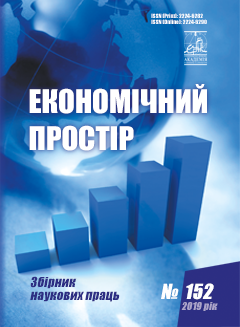THE FRAGILITY AS A STRATEGIC PROBLEM OF GLOBAL EXPONENTIAL ORGANIZATIONS
Abstract
The author's method of identifying the organization as exponential and defining problems that are of strategic importance for its activity has been presented in the article. In general, exponential organizations can be defined as having business experience or resulting from reorganization processes, characterized by a high degree of updating of strategic guidelines (organizational methods and structure, management strategies, employees, scientific ideas, production technologies, products), has "big numbers" (sales, revenue, R&D, market capitalization, market share, R&D employees, patent activity) and has a significant impact on the socio-economic level of human life. It has been revealed that the priority branches of operations of exponential organizations are relatively young industries (in particular "Digital equipment and microelectronics", "Software and computer services", "Pharmaceuticals and biotechnologies", "Chemistry and cosmetics"), for which high patent activity level and significant investments in exponential technologies. The example of Microsoft Corporation, Intel Corporation, and Apple Inc. is shown and it has been stated that the strategy of exponential organizations should be focused on timely recognition of key business events (exponential depreciation of products and development of ideas, elimination of a strategic competitor, ensuring long-term competitive advantage, fragility of platform companies, variety of tactics of competitive struggle) and (predict; know when you can take significant risks; transform yourself into a platform company; create an industry ecosystem, Curb competitors). It is hypothesized that the strategic problem of exponential organizations is fragility - balancing on the brink of high profits and high risks as a result of the vulnerability to ultra-fast devaluation of ideas, products, information and activities of extremely vigilant competitors, which are also developing along an exponential trajectory. Fragility counteracts, above all, the leader of a company that, recognizing key events, effectively builds business strategy and tactics, pursues a "scaling" philosophy to ensure "big numbers" and tangible impact of the company on the global community as a sign of its success.
References
Cusumano M. A., Selby R. W. (1995). Microsoft secrets: how the world's most powerful software company creates technology, shapes markets, and manages people, New York, A Division of Simon & Schuster Inc., P. 512. Retrieved from: https://archive.org/stream/microsoftsecrets00cusu#page/512/mode/2up
Cusumano M. A., Yoffie D. B. (2015). Strategy Rules: Five Timeless Lessons from Bill Gates, Andy Grove, and Steve Jobs, New York, P. 260. Retrieved from: https://archive.org/stream/strategyrulesfiv0000yoff#page/258/mode/2up
Chase R. B., Jacobs F. R., Aquilano N. J. (2004). Operations management for competitive advantage, 10th edition, Boston, McGrow-Hill, P. 788 Retrieved from: https://archive.org/details/operationsmanage00rich/page/n5
Christensen C. M., Raynor M. E., McDonald R. (2015). What Is Disruptive Innovation? Harvard Business Review, December. Retrieved from: https://hbr.org/2015/12/what-is-disruptive-innovation
Ismail S., Malone M. S., van Geest Y. (2014). Exponential Organizations: Why New Organizations are Ten Times Better, Faster, and Cheaper than Yours (and What to Do About It), New York, A Division of Diversion Publishing Corp., P. 326. Retrieved from: https://www.8freebooks.net/download-exponential-organizations-salim-ismail-pdf/
Gawer А., Cusumano М. (2002). Platform Leadership: How Intel, Microsoft, and Cisco Drive Industry Innovation, Harvard Business School Press, Р. 336. Retrieved from: https://openlibrary.org/books/OL8754181M/Platform_Leadership
Lyons К. (2020). Google parent Alphabet is now a $1 trillion company. – Retrieved from: https://www.theverge.com/2020/1/16/21069458/google-alphabet-trillion-dollar-market-cap-apple-microsoft
Strategy Analytics (2020). Strategy Analytics: Huawei & Samsung Capture 73 Percent Share of Global 5G Smartphone Shipments in 2019. Retrieved from: https://news.strategyanalytics.com/press-release/devices/strategy-analytics-huawei-samsung-capture-73-percent-share-global-5g
Samsung Electronics (2019). Sustainability Report 2019: A fifty year journey towards a sustainable future. Retrieved from: https://images.samsung.com/is/content/samsung/p5/global/ir/docs/sustainability_report_2019_en_new.pdf
Huawei Investment & Holding Co., Ltd. (2019) 2018 Annual Report. Retrieved from: https://www.huawei.com/en/press-events/annual-report
Bloomberg Finance L.P. (2019). No Pay, No Gain: Huawei Outspends Apple on R&D for a 5G Edge. Retrieved from: https://www.bloomberg.com/news/articles/2019-04-25/huawei-s-r-d-spending-balloons-as-u-s-tensions-flare-over-5g
The economist (2020). Huawei is a cyber-security risk. The economist. Retrieved from: https://www.economist.com/leaders/2020/01/25/huawei-is-a-cyber-security-risk?cid1=cust/dailypicks1/n/bl/n/20200124n/owned/n/n/dailypicks1/n/n/E/387307/n
Thomson Reuters (2012). Thomson Reuters 2012 Top 100 Global Innovators. Honoring the world leaders in innovation: findings and methodology 2012.
Huawei Technologies Co., Ltd. & Oxford Economics (2017). Digital Spillover: Measuring the true impact of the digital economy. Retrieved from: https://www.huawei.com/minisite/gci/en/digital-spillover/files/gci_digital_spillover.pdf
European Commission (2014). The 2014 EU Industrial R&D Investment Scoreboard. Luxembourg, 96 p. Retrieved from: https://publications.jrc.ec.europa.eu/repository/handle/JRC92506 doi:10.2791/13983.
European Commission (2019). The 2019 EU Industrial R&D Investment Scoreboard. Luxembourg, 120 p. Retrieved from: https://www.kowi.de/Portaldata/2/Resources/fp/2019-EU-Industrial-RD-Investment-Scoreboard.pdf doi:10.2760/04570.
European Commission (2019). R&D ranking of the world top 2500 companies. Retrieved from: https://iri.jrc.ec.europa.eu/scoreboard/2019-eu-industrial-rd-investment-scoreboard#field_data
Thomson Reuters (2013). Thomson Reuters 2013 Top 100 Global Innovators. Honoring the world leaders in innovation: findings and methodology 2013. Retrieved from: https://www.fichier-pdf.fr/2013/12/24/thomson-reuters-2013-top-100-global-innovators/thomson-reuters-2013-top-100-global-innovators.pdf
Thomson Reuters (2014). Thomson Reuters 2014 Top 100 Global Innovators. Honoring the world leaders in innovation: findings and methodology 2014.
Thomson Reuters (2015). Thomson Reuters 2015 Top 100 Global Innovators. Honoring the world leaders in innovation: findings and methodology. Featuring a special supplement
on the Top Bay Area Innovators. Retrieved from: http://static.latribune.fr/521753/classement-entreprises-innovantes.pdf
Clarivate Analytics (2016). 2016 Top 100 Global Innovators Report. Retrieved from: https://vdocuments.net/2016-top-100-global-innovators-report.html
Clarivate Analytics (2018). Derwent Top 100 Global Innovators 2017. Retrieved from: http://yaskawa.co.il/wp-content/uploads/2016/05/Clarivate-Analytics-2017-Top-100-Global-Innovators-ilovepdf-compressed.pdf
Clarivate Analytics (2019). Derwent Top 100 Global Innovators 2018-19. Retrieved from: https://clarivate.com/derwent/wp-content/uploads/sites/3/dlm_uploads/2019/07/0192_Clarivate_Top100_Final.pdf
Clarivate Analytics (2020). Derwent Top 100 Global Innovators 2020. Retrieved from: https://clarivate.com/derwent/wp-content/uploads/sites/3/dlm_uploads/2020/02/Top100_FINAL_DigitalONLY.pdf



